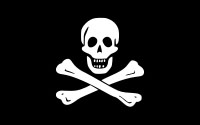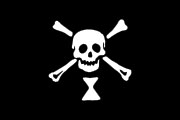Download ebook of Buried Treasure and Lost Gold Mines |
Treasure Stories |
| HOME |
| Florida's Pirate |
| Finding Treasure |
| Lost Dutchman |
| USS Enterprise |
| Pirate Flags |
| Author |
Ships & Coins |
| Treasure Coins |
| Sailing Ships |
Jolly Roger
From Wikipedia, the free encyclopedia

The Jolly Roger is the name given to any of various flags flown to identify a ship's crew as pirates The flag most usually identified as the Jolly Roger today is the skull and crossbones, being a flag consisting of a skull above two long bones set in an x-mark arrangement on a black field. This design was used by four pirates, captains Edward England, John Taylor, Sam Bellamy and John Martel. Despite its appearance in popular culture, plain black flags were often employed by most pirates in the 17th-18th century. Historically, the flag was flown to frighten pirates' victims into surrendering without a fight, since it conveyed the message that the attackers were outlaws who would not consider themselves bound by the usual rules of engagement -- and might, therefore, slaughter those they defeated. (Since captured pirates were usually hanged, they didn't have much to gain by asking quarter if defeated.) The same message was sometimes conveyed by a red flag, as discussed below.
Since the decline of piracy, various military units have used the Jolly Roger, usually in skull-and-crossbones design, as a unit identification insignia or a victory flag to ascribe to themselves the proverbial ferocity and toughness of pirates. It has also unofficially been used to signify Electric Hazard. The background is blood red and the Skull and Bones are black in color.
Origins of the term
The name "Jolly Roger" goes back at least to Charles Johnson's A General History of the Pyrates, published in 724. Johnson specifically cites two pirates as having named their flag "Jolly Roger": Bartholomew Roberts in June, 1721 and Francis Spriggs in July, 1723. While Spriggs and Roberts used the same name for their flags, their flag designs were quite different, suggesting that already "Jolly Roger" was a generic term for black pirate flags rather than a name for any single specific design. Neither Spriggs' nor Roberts' Jolly Roger consisted of a skull and crossbones.
Richard Hawkins, captured by pirates in 1724, reported that the pirates had a black flag bearing the figure of a skeleton stabbing a heart with a spear, which they named "Jolly Roger".
Despite this tale, it is assumed by most that the name Jolly Roger comes from the French words jolie rouge, meaning "pretty red". Supporting this theory is that during the Elizabethan era "Roger", which was derived from the French "rouge", was a slang term for beggars and vagrants who "pretended scholarship" and was also applied to privateers who operated in the English Channel. "Sea Beggars" had been a popular name for Dutch privateers since the 16th century. Another theory states that "Jolly Roger" is an English corruption of "Ali Raja", the name of a Tamil pirate. Yet another theory is that it was taken from a nickname for the devil, "Old Roger". The "jolly" appellation may be derived from the apparent grin of a skull. (Theories that the epithet comes from the names of various pirates, such as Woodes Rogers, are generally discredited.)
Origins of the design

While privateers are shown in earlier Dutch paintings flying a red flag, the first written record of what it was used for occurred in 1694 when an English Admiralty law made the flying of a red flag, known as a "Red Jack", mandatory to distinguish them from Navy ships. The first references to a black flag are contained in records of privateering actions dated 1697. These records show that when the victim's vessel showed resistance, the Red Jack was lowered and a black flag raised in its place to indicate no quarter would be given. A yellow flag was also used but there is no record of its meaning. With the end of the War of the Spanish Succession in 1714, many of the privateers turned to piracy and continued to use the red and black flags but now decorated with their own designs. Edward England, for example, flew the black flag depicted above from his mainmast, a red version of the same flag from his foremast, and the English National flag from his ensign staff.

The first record of the skull and crossed bones design being used by pirates is an entry in a log book held by the December 6th 1687 it describes its use by pirates not on a ship but on land.
"And we put down our white flag, and raised a red flag with a Skull head on it and two crossed bones (all in white and in the middle of the flag), and then we marched on."
Black flags are known to have been used by pirates at least five years before the earliest known attachment of the name "Jolly Roger" to such flags. Contemporary accounts show Captain Martel's pirates using a black flag in 1716, Edward Teach, Charles Vane, and Richard Worley in 1718, and Howell Davis in 1719. An even earlier use of a black flag with skull, crossbones, and hourglass is attributed in 1700 to pirate captain Emanuel Wynn, according to a wide variety of secondary sources. Reportedly, these secondary sources are based on the account of Captain John Cranby of the HMS Poole and are verified at the London Public Record Office.

Pirates did not fly the Jolly Roger at all times. Like other vessels, pirate ships usually stocked a variety of different flags, and would normally fly false colors or no colors until they had their prey within firing range. When the pirates' intended victim was within range, the Jolly Roger would be raised, often simultaneously with a warning shot.
The flag was probably intended as communication of the pirates' identity, which may have given target ships an opportunity to change their mind and surrender without a fight. For example in June 1720 when Bartholomew Roberts sailed into the harbour at Trepassey, Newfoundland with black flags flying, the crews of all 22 vessels in the harbour abandoned them in panic. If a ship then decided to resist, the Jolly Roger was taken down and a red flag was flown, indicating that the pirates intend to take the ship by force and without mercy. Richard Hawkins reports that "When they fight under Jolly Roger, they give quarter, which they do not when they fight under the red or bloody flag."

In this view of models, it was important for a prey ship to know that its assailant was a pirate, and not a privateer or government vessel - as the latter two generally had to abide by a rule that a crew that resisted, but then surrendered, could not be executed:
"An angry pirate therefore posed a greater danger to merchant ships than an angry Spanish coast guard or privateer vessel. Because of this, although, like pirate ships, Spanish coast guard vessels and privateers were almost always stronger than the merchant ships they attacked, merchant ships may have been more willing to attempt resisting these "legitimate" attackers than their piratical counterparts. To achieve their goal of taking prizes without a costly fight, it was therefore important for pirates to distinguish themselves from these other ships also taking prizes on the seas."
Flying a Jolly Roger was a reliable way of proving oneself a pirate, as just possessing or using a Jolly Roger was considered proof that one was a criminal pirate (and not something more legitimate); only a pirate would dare fly the Jolly Roger, as they were already under threat of execution.
